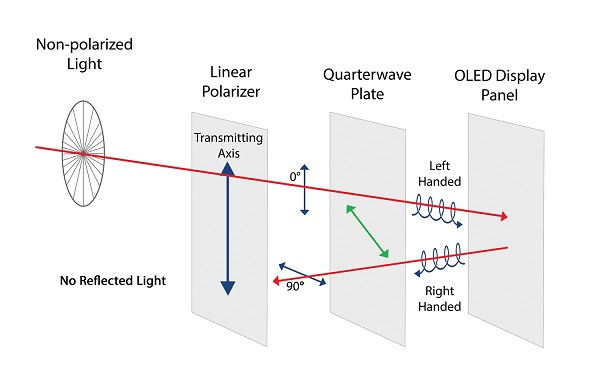Light Polymers is announcing a next-generation circular polarizer for OLED displays based on lyotropic liquid crystal technology. Light Polymers’ proprietary nanochemistry creates a circular polarizer at 45 µm, thinner than any competitive offering.
 |
|
Without the circular polarizer, an OLED panel would act just like a mirror. (Image: Light Polymers) |
A circular polarizer is an essential part of an OLED display as the component which reduces the reflections of light off of the mirror-like surface of an OLED panel. Without the circular polarizer, an OLED panel would act just like a mirror, reflecting all of the light back and rendering the OLED display unreadable. The major trend in the smartphone market this year is borderless displays with edge-to-edge screen, one of the major advances in Apple’s iPhone X. These phones use what is called a “Flexible OLED Display,” as it can wrap around the edge of the smartphone, and it is widely used in Samsung’s Galaxy smartphone offering as well. Light Polymers is now working on a foldable version of this circular polarizer and since its technology is the thinnest, significant progress has been made with a possible introduction in 2018. This technology pushes the industry one step closer to making foldable displays.
Light Polymers’ polarizer chemistry is water-based and can be coated using industry standard coating equipment at nearly room temperature without high drying temperatures. “Polarizers are a fundamental part of any flat panel display technology, including OLED,” said Marc McConnaughey, President/CEO of Light Polymers. “The polarizer industry’s current technology is nearly forty years old and based on PVA or polyvinyl alcohol which requires significant capital expense. One production line is over $50M and makes 30-40M m2 per year. Our polarizer nanochemistry enables the industry to use production lines at 1/10th the capex costs and utilizes much less energy and processing additives.”
This advance in new materials science is made possible by Light Polymers’ proprietary lyotropic liquid crystal chemistry. Light Polymers’ lyotropic polarizer costs less to manufacture and exhibits better technical characteristics - making it a truly evolutionary step in OLED polarizer technology.





 CN
TW
EN
CN
TW
EN






